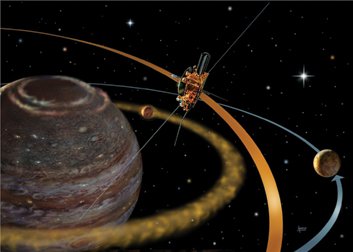|
My note: This article
strengthens my supposition that the solar system digests dust;
that - far from being a minor curiosity, it is evidence if the
universality of life. The solar system's treatment of interstellar
dust assures an orderly transition and distribution of this
consumable resource.
It's Raining Stardust: Spacecraft measures record amount of
stellar debris
Ron Cowen
Intruder alert! Stardust is sneaking into our solar system at
three times the rate that it was just 6 years ago. Moreover, the
influx of dust could triple again by the end of 2010.
 |
|
DUST COLLECTOR. Artist's view of the
Ulysses spacecraft, which has flown over the sun's
poles.
European
Space Agency
|
These findings are based on the latest measurements by the
Ulysses spacecraft, launched in 1990 to become the first
observatory to explore the sun's poles. Before Ulysses' tour,
which takes it from Jupiter's neighborhood to far above the solar
poles, most astronomers didn't think much dust from other stars
could penetrate the solar system. Sunlight rapidly charges dust
attempting to enter the solar system, and, according to
conventional theory, the sun's magnetic field then ejects the
particles.
But in 1993, the space probe found that some particles barrel
through the sun's magnetic shield. During solar maximum, when
activity on the sun is most intense, even more stardust
penetrates. That's because the sun's magnetic field begins
flipping polarity, and the disordered field can't efficiently
deflect dust particles.
Yet even though solar maximum ended in 2001, the rate at which
stardust enters the solar system has remained high, report Markus
Landgraf of the European Space Agency in Darmstadt, Germany, and
his colleagues in the October Journal of Geophysical Research.
The explanation lies in the gradual way that the magnetic field
changes polarity, Landgraf says. The field is now pointing nearly
sideways, with its north and south magnetic poles lying along the
sun's equator. In this configuration, the direction of the
magnetic field rotates along with the sun every 28 days. Because
the dust takes several months to react to the magnetic field, it
experiences an average magnetic force of nearly zero. As a result,
the magnetic field is now ineffective as a gatekeeper.
When the magnetic field finishes the reversal it began in 2001,
it will focus stardust into the plane in which the planets orbit
rather than expel the material. Landgraf says that he expects that
the rate at which stardust enters the solar system will increase
through about 2010.
About 0.6 micrometer in diameter, the particles are several
times larger, and hence more massive, than astronomers had
predicted. Greater mass may help the dust particles infiltrate the
solar system.
Although the particles are still too tiny to affect the
planets, their abundance probably leads to more collisions with
comets and asteroids than usual, says Landgraf. That would result
in more asteroid and comet fragments being generated.
These findings bode well for the Stardust space probe, which is
scheduled to bring samples of cometary and stardust particles to
Earth in 2006. The increased amount of stardust and the particles'
larger-than-expected size should make for greater,
easier-to-detect samples, says Stardust investigator Donald E.
Brownlee of the University of Washington in Seattle.
"People often think of dust as trivial, but it's a major
character in the solar system and throughout the galaxy," he
says. Not only does dust absorb starlight, reradiating it as heat,
it ferries such elements as iron, carbon, and silicon into the
solar system, Brownlee notes.
Studying stardust near our sun, adds Landgraf, offers clues to
how other stars interact with their surroundings.
****************
If you have a comment on this article that you would like
considered for publication in Science News, send it to editors@sciencenews.org.
Please include your name and location.
To subscribe to Science News (print), go to https://www.kable.com/pub/scnw/
subServices.asp.
To sign up for the free weekly e-LETTER from Science News,
go to http://www.sciencenews.org/subscribe_form.asp.
|